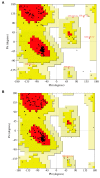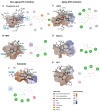Computational Modeling Study of the Binding of Aging and Non-Aging Inhibitors with Neuropathy Target Esterase
- PMID: 38067477
- PMCID: PMC10708158
- DOI: 10.3390/molecules28237747
Computational Modeling Study of the Binding of Aging and Non-Aging Inhibitors with Neuropathy Target Esterase
Abstract
Neuropathy target esterase (NTE) is a serine hydrolase with phospholipase B activity, which is involved in maintaining the homeostasis of phospholipids. It can be inhibited by aging inhibitors such as some organophosphorus (OP) compounds, which leads to delayed neurotoxicity with distal degeneration of axons. However, the detailed binding conformation of aging and non-aging inhibitors with NTE is not known. In this study, new computational models were constructed by using MODELLER 10.3 and AlphaFold2 to further investigate the inhibition mechanism of aging and non-aging compounds using molecular docking. The results show that the non-aging compounds bind the hydrophobic pocket much deeper than aging compounds and form the hydrophobic interaction with Phe1066. Therefore, the unique binding conformation of non-aging compounds may prevent the aging reaction. These important differences of the binding conformations of aging and non-aging inhibitors with NTE may help explain their different inhibition mechanism and the protection of non-aging NTE inhibitors against delayed neuropathy.
Keywords: computational modeling; molecular docking; neuropathy target esterase.
Conflict of interest statement
The authors declare no conflict of interest.
Figures







Similar articles
-
Interactions between neuropathy target esterase and its inhibitors and the development of polyneuropathy.Toxicol Appl Pharmacol. 1993 Oct;122(2):165-71. doi: 10.1006/taap.1993.1184. Toxicol Appl Pharmacol. 1993. PMID: 8211998 Review.
-
Neuropathy target esterase in mouse whole blood as a biomarker of exposure to neuropathic organophosphorus compounds.J Appl Toxicol. 2016 Nov;36(11):1468-75. doi: 10.1002/jat.3305. Epub 2016 Mar 11. J Appl Toxicol. 2016. PMID: 26970094
-
Interactions in vitro of some organophosphoramidates with neuropathy target esterase and acetylcholinesterase of hen brain.J Biochem Toxicol. 1993 Mar;8(1):19-31. doi: 10.1002/jbt.2570080105. J Biochem Toxicol. 1993. PMID: 8492300
-
Discrimination of carboxylesterases of chicken neural tissue by inhibition with a neuropathic, non-neuropathic organophosphorus compounds and neuropathy promoter.Chem Biol Interact. 1997 Oct 24;106(3):191-200. doi: 10.1016/s0009-2797(97)00064-1. Chem Biol Interact. 1997. PMID: 9413546
-
Neuropathy target esterase (NTE): overview and future.Chem Biol Interact. 2013 Mar 25;203(1):238-44. doi: 10.1016/j.cbi.2012.10.024. Epub 2012 Dec 3. Chem Biol Interact. 2013. PMID: 23220002 Review.
References
-
- UniProt UniProtKB—Q8IY17 (PLPL6_HUMAN) 2019. [(accessed on 26 November 2019)]. Available online: http://www.uniprot.org/uniprot/Q8IY17.
MeSH terms
Substances
Grants and funding
LinkOut - more resources
Full Text Sources
Research Materials
Miscellaneous

